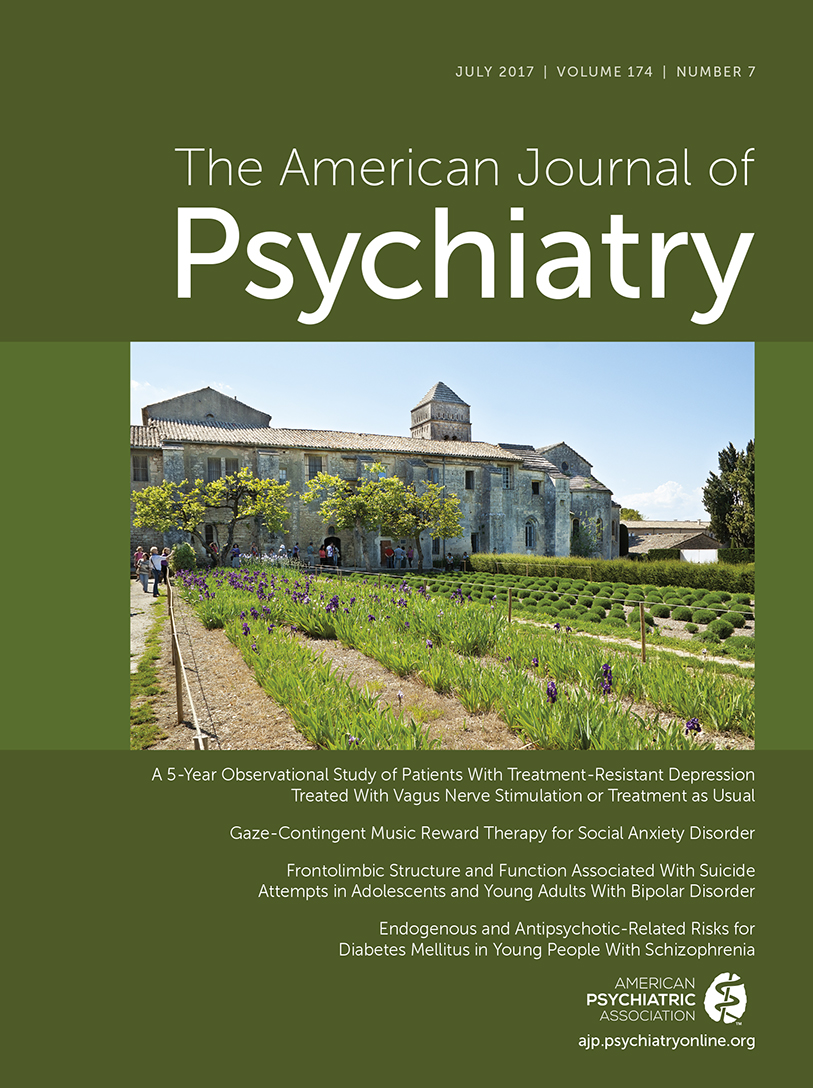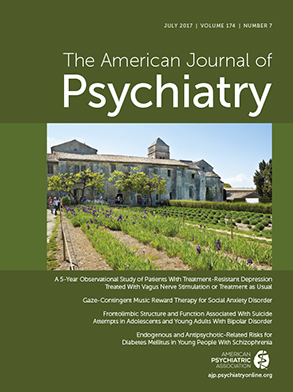In the power of gaze, we are connected. However, for people with social anxiety disorder, gaze and attentional biases become the means of isolation. Cognitive models of generalized social anxiety disorder postulate that attentional biases create a negative feedback loop in the milieu of social interaction (
1). In particular, studies have suggested that patients with social anxiety demonstrate a bias toward greater threat detection as well as a bias in difficulty with disengagement of threat (
2). Furthermore, as suggested by the Clark and Wells cognitive model (
3), inward attentional focus on the threat of anxiety symptoms leads outwardly to the use of gaze avoidance that further affects a person’s ability to navigate social interactions. Although avoidance of gaze may serve as a temporary safety signal, it ultimately reinforces anxiety by affecting the person’s interpersonal engagement or by preventing detection of disconfirming evidence. Thus, despite “objectively” being exposed to a social situation, the attentional biases for a person with social anxiety perpetuate a negative feedback loop among social situations, anxiety, and negative beliefs.
With attentional biases playing a possible maintenance role within social anxiety, these processes have become a target for intervention. A number of attention bias modification interventions have been developed using computer tasks, such as responding to the presence of a dot probe, to retrain attentional biases away from threat. Although the studies may vary in their nuances, a substantial body of research has accrued, suggesting mixed impact on attentional processes and, by extension, social anxiety (
4,
5). One caveat is that many attention bias modification tasks generally rely on the procedure of reaction time as a measure of attentional process and bias. However, as a downstream effect, reaction time may be a problematic proxy because of confounding factors of other cognitive processes, such as interpretational factors or motivational engagement.
In response to these criticisms of attention bias modification interventions, Lazarov et al. (
6) in this issue report on a novel intervention that assesses the focus of gaze rather than the use of reaction time as an outcome measure. In this study, subjects who met criteria for generalized social anxiety were asked to participate in free visual search on matrices that included an equal number of disgusted and neutral facial expressions. For subjects who were assigned to the interventional condition, pleasant music was played during the time in which the subject’s gaze was allotted on the neutral faces or “region of interest”; music ceased when the gaze was focused on the disgusted faces. Subjects assigned to the placebo control condition heard their music throughout the free visual search paradigm independent of their gaze. Training sessions occurred for 20 minutes, twice a week, for 4 weeks. Strengths of the study included the use of a clinically generalizable sample, the use of different matrix materials for assessment and for training, and a follow-up assessment to ascertain the durability of the interventions.
Following this 1-month intervention, subjects in the music-contingent condition were significantly more likely to have reductions not only in terms of time spent on disgusted faces but also on the clinical measures of social anxiety when compared with subjects in the placebo condition. Of particular interest, using the Liebowitz Social Anxiety Scale (LSAS) as the outcome measure, 70% of the gaze-contingent group met criteria for clinically significant change at treatment endpoint compared with 30% of the subjects in the placebo condition. Results were maintained at the 3-month follow-up, with 75% of the gaze-contingent subjects meeting clinically significant change compared with 30% of the placebo group. Of note, the LSAS mean scores at both posttreatment and follow-up were still in the range for at least moderately severe social anxiety; however, the clinical impact of a relatively brief intervention suggests that such a method of retraining could potentially enhance treatment outcomes within a more comprehensive cognitive-behavioral treatment.
As with any key learning from a study, the findings from the Lazarov et al. study lead to more questions. On the surface, the intervention appears to suggest a positive reinforcement paradigm that allowed for discriminatory learning. However, could similar results occur from any type of positive reinforcement? Or, potentially, did music enhance the learning? Although all subjects were given exposure to music, the intermittent onset of music with the neutral face gazing may have promoted additional neural plasticity for retraining this attentional bias. This speculation could find some support from various preclinical and clinical studies on the impact of music for cognitive performance (
7). Alternatively, music can “soothe the savage beast” and thus, perhaps the gaze-contingent music evoked emotional states that also served as a safety signal to allow one to look away from threatening stimuli. As another hypothesis, the findings could have been due to explicit knowledge gained by the subjects through the trials. As the authors recognized, the study did not assess whether the subjects also obtained explicit knowledge of the gaze contingency through the trials and therefore became proactive in directing their attention. In this explanation, music could have served as a biofeedback to help guide subjects to actual awareness of their gaze. Clinically, if gaze can be naturalistically assessed and modified through contingent reinforcement and explicit knowledge, individuals with social anxiety could begin to track their own success in attending to task-relevant, external cues instead of to internal anxiety “threat cues.” Fundamentally, though, the Lazarov et al. study provides an intriguing example of how to harness the power of gaze for individuals with social anxiety and offer a way to make new connections.

